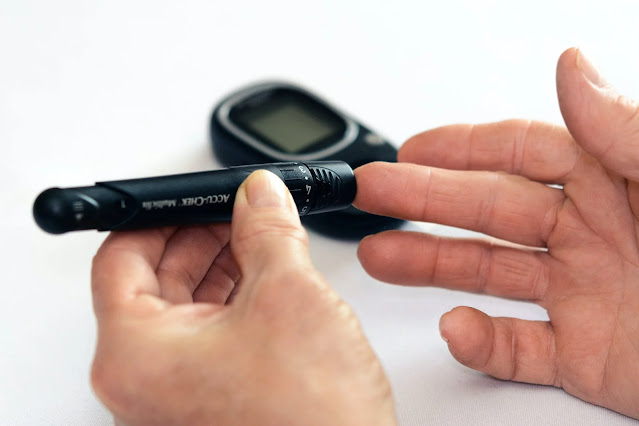Expert tips for preventing and treating diabetic foot care from a podiatrist
Expert tips for preventing and treating diabetic foot care from a podiatrist
Expert tips for preventing and treating diabetic foot care from a podiatrist, Diabetes is a chronic illness that can affect many parts of the body, including the feet.
.webp) |
Expert tips for preventing and treating diabetic foot care from a podiatrist |
High blood sugar levels can damage nerves and blood vessels, leading to poor circulation and loss of sensation in the feet.
This can make it difficult to feel pain or notice injuries, which can lead to serious complications such as infections and ulcers.
A podiatrist is a highly skilled and experienced medical practitioner who focuses on the examination, diagnosis, and treatment of various foot-related conditions and ankle problems.
For people with diabetes, regular visits to a podiatrist are essential for maintaining good foot health.
A podiatrist can provide education on proper foot care, perform regular foot exams, and treat any problems that may arise.
Diabetic foot care is a crucial component of diabetes management. According to the Mayo Clinic, people with diabetes should inspect and wash their feet daily, wear properly fitting shoes, and avoid going barefoot.
They should also have regular foot exams by a podiatrist to check for any signs of problems. By taking good care of their feet and working with a podiatrist, people with diabetes can reduce their risk of serious foot complications.
The Importance of Diabetic Foot Care
Diabetes is a chronic disease that affects millions of people worldwide. Foot problems are a prevalent complication that people with diabetes often experience. In fact, about 15% of people with diabetes develop foot ulcers, which can lead to serious infections and even amputations.
Therefore, it is crucial for people with diabetes to take care of their feet to prevent these complications.
Why Diabetic Foot Care is Important
People with diabetes are at a higher risk for foot problems due to nerve damage and poor blood flow to the feet.
This can lead to dry skin, calluses, corns, blisters, and even infections. In severe cases, it can lead to foot ulcers and amputations. However, most foot problems can be prevented with proper foot care.
Regular foot care can help people with diabetes avoid foot problems and detect any issues early on.
This includes daily foot inspections, wearing proper footwear, keeping feet clean and dry, and avoiding hot water and heating pads.
Additionally, managing blood sugar levels can also help prevent foot problems.
The Role of a Podiatrist in Diabetic Foot Care
Podiatrists are medical professionals who specialize in foot care. They can play a crucial role in diabetic foot care by helping to prevent and treat foot problems.
Podiatrists can provide regular foot exams, treat foot problems such as calluses and infections, and provide education on proper foot care.
Podiatrists can also help people with diabetes manage their foot health by recommending proper footwear, providing custom orthotics, and monitoring foot health during physical activity.
Additionally, podiatrists can work with other healthcare professionals to ensure that people with diabetes receive comprehensive care for their foot health.
In conclusion, diabetic foot care is essential for people with diabetes to prevent foot problems and complications.
Regular foot care, including daily foot inspections and proper footwear, can help prevent foot problems.
Additionally, podiatrists can play a vital role in diabetic foot care by providing regular foot exams, treating foot problems, and providing education on proper foot care.
Common Foot Problems in Diabetics
People with diabetes are at an increased risk of developing foot problems due to high blood sugar levels that can damage the nerves and blood vessels in the feet.
It is important for diabetics to take good care of their feet to prevent complications that can lead to amputations.
The most common foot problems in diabetics are neuropathy, peripheral artery disease, and infections.
Neuropathy
Neuropathy is a condition where the nerves in the feet are damaged, causing numbness, tingling, burning, and pain.
Diabetic neuropathy can make it difficult to feel injuries, sores, or blisters on the feet, which can go unnoticed and become infected.
Diabetics should inspect their feet daily for any signs of injury or infection and seek medical attention if they notice any changes.
Peripheral Artery Disease
Peripheral artery disease (PAD) is a condition where the blood vessels in the legs and feet become narrow or blocked, reducing blood flow to the feet.
Diabetics with PAD may experience pain or cramping in the legs or feet, slow-healing wounds, and coldness or numbness in the feet. Diabetics should quit smoking, control their blood sugar levels, and exercise regularly to prevent PAD.
Infections
Diabetics are more susceptible to infections due to weakened immune systems and poor circulation.
Any injury to the feet, no matter how small, can lead to an infection that can spread quickly and become life-threatening.
Diabetics should wash their feet daily, keep them dry, and wear shoes that fit well to prevent infections.
They should also seek medical attention if they notice any signs of infection, such as redness, swelling, warmth, or drainage.
Preventative Measures for Diabetic Foot Problems
Daily Foot Care Routine
People with diabetes are at a higher risk of developing foot problems, so it is important to establish a daily foot care routine.
This routine should include inspecting the feet for any cuts, blisters, or sores. If any of these are found, they should be treated immediately to prevent infection.
It is also important to wash the feet daily with lukewarm water and mild soap and to dry them thoroughly, especially between the toes.
Moisturizing the feet with lotion can also help prevent dry skin and cracking.
Trimming the toenails regularly and properly is also an important part of daily foot care. Nails should be trimmed straight across and not too short to avoid ingrown toenails.
It is also important to avoid using sharp objects to remove any calluses or corns, as this can cause injury and infection.
Footwear Considerations
Wearing proper footwear is crucial for people with diabetes. Shoes should fit properly and be comfortable, with enough room for the toes to move freely.
Shoes with a wide and deep toe box are recommended to reduce pressure on the toes. Avoid shoes with pointed toes or high heels, as they can cause blisters and calluses.
It is also important to wear socks that fit well and are made of breathable materials, such as cotton or wool.
Socks should be changed daily and washed in warm water. Avoid wearing socks with seams or elastic bands that can cause irritation or restrict blood flow.
Regular Podiatrist Visits
Regular visits to a podiatrist are important for people with diabetes to prevent foot problems.
A podiatrist can check for any signs of foot problems, such as nerve damage or poor circulation, and provide treatment if necessary.
They can also offer advice on proper foot care and footwear.
People with diabetes should have their feet checked by a podiatrist at least once a year, and more frequently if they have any foot problems or complications.
It is important to inform the podiatrist of any changes or concerns about the feet, such as swelling, pain, or numbness.
Treatment Options for Diabetic Foot Problems
When it comes to treating diabetic foot problems, there are several options available. Treatment will depend on the severity of the condition and the individual's specific needs.
A podiatrist will work with the patient to create a treatment plan that is tailored to their needs.
Wound Care
Wound care is an essential part of treating diabetic foot problems. A podiatrist will clean the wound and remove any dead tissue.
They may then apply a dressing to the wound to keep it clean and promote healing. In some cases, a podiatrist may use special dressings or topical medications to help the wound heal.
It's important to keep the wound clean and dry to prevent infection. A podiatrist may recommend certain products, such as special socks or shoes, to help protect the wound and prevent further damage.
Orthotics and Braces
Orthotics and braces can be used to help prevent diabetic foot problems from getting worse. A podiatrist may recommend custom orthotics to help distribute pressure evenly across the foot. This can help reduce the risk of developing ulcers or other foot problems.
Braces may also be used to help support the foot and ankle. This can be especially helpful for individuals who have weak or unstable ankles.
Surgery
In some cases, surgery may be necessary to treat diabetic foot problems. This may include removing infected tissue, repairing damaged nerves, or even amputating a toe, foot, or part of the leg.
A podiatrist will work with the patient to determine if surgery is necessary and what type of surgery is best. They will also provide guidance on post-surgery care to ensure proper healing.
Overall, there are many treatment options available for diabetic foot problems. It's important to work with a podiatrist to create a treatment plan that is tailored to the individual's needs.


.webp)
.webp)
(1).webp)
